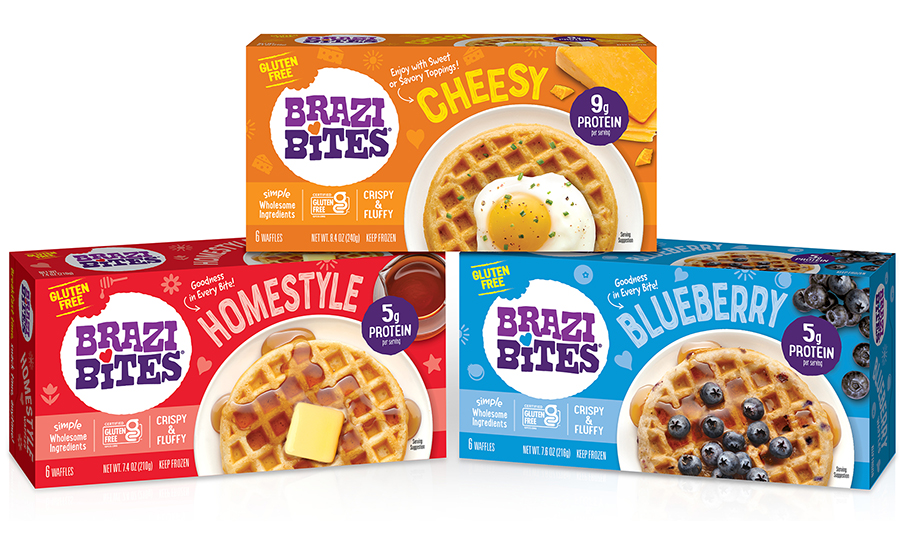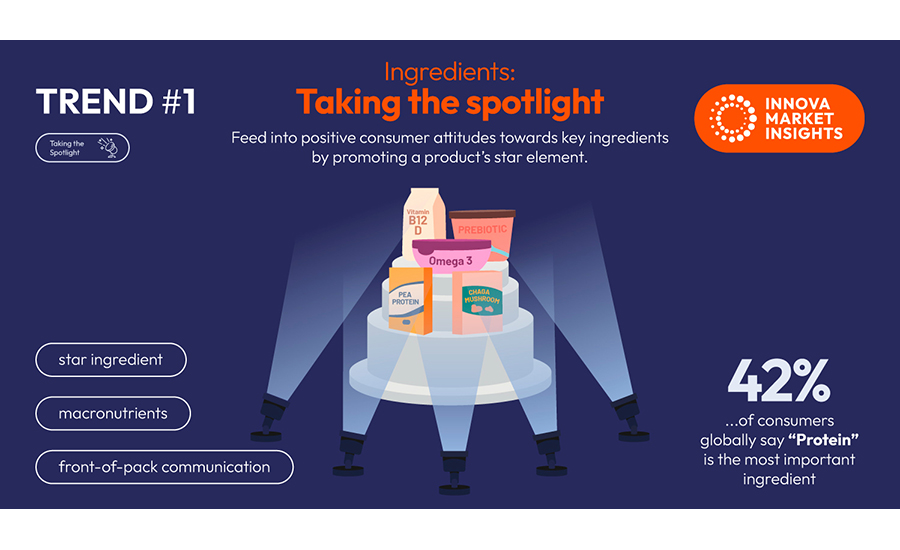PREDICTIONS 2024
Top 10 Food & Beverage Consumer Trends in 2024
Innova Market Insights finds consumers interested in key benefits, ingredients, transparency

Front and Center: Pitaya Foods calls out functional benefit, functional nutrients.
PHOTO COURTESY OF: Pitaya Foods

Protein Power! New offering combines ethnic adventure with “protein packed” benefits.
PHOTO COURTESY OF: Somos Amigos / SOMOS Foods

Plant-Based Goes Premium: Daiya’s Deluxe Mac & Cheeze extends plant-based offerings with “decadent” sauces, on-trend flavors.
PHOTO COURTESY OF: Daiya Foods Inc.

Brazi Bites said social media (the viral #WillitWaffle) prompted it to create its new gluten-free Waffles line. The three-item line includes a savory Cheesy Waffle. The product offers 5g of protein per serving and is suitable for vegetarians.
PHOTO COURTESY OF: Brazi Bites

Ocean Appeal: 12 Tides sources organic kelp from small-scale ocean farms.
PHOTO COURTESY OF: Tidal Foods Inc.







It’s that time again: trends season! Innova Market Insights takes great pride in our contributions to the exciting food and beverage trends landscape. We interview thousands of consumers in representative countries around the world, browse the halls of leading food and ingredient shows learning about new products, and monitor new retail and e-commerce launches to give us a 360-degree view of the future direction of the industry.
Every year, we compile our Top Ten Food & Drink Trends, based partly on direct consumer research to identify shifts in behavior and preference and partly on which products are being launched and how they and their ingredients are described on-pack. Our latest research shows that food price inflation and the need to cut back on expenses continue to affect consumer markets worldwide. For many families, simply finding the food they need at a price they can afford is the primary challenge. But consumers also tell us—and show us in the products they buy—that other considerations come into play in their decision making.
We expect our Top 10 Trends 2024 to include eye-catching and well-loved ingredients, nature-friendly claims, and health benefits that inspire higher spending into 2024.
1. Taking the spotlight:
Topping Innova's 2024 list is the way that particular ingredients and foods are “taking the spotlight” in the eye of the consumer and on packaging. One-third of the consumers we polled said they respond positively to certain key ingredients being flagged up on labels, meaning that they appreciate having their attention drawn to particular product features. The features could be sensory, for example a trending flavor or unique texture; better-for-you; nostalgic or memory evoking; following a social media trend; or highlighted in the media, for example, superfoods or probiotic bacteria.
It’s no surprise to see the spotlight shine on a nutrient such as protein, or a particular food like mushrooms. In one example from our global research, 42% of consumers reported that protein was the most important ingredient in food and beverage products. We also expect to see a continuing stream of new launches featuring mushrooms. Main meals featuring mushrooms (or specific mushroom types) as an ingredient grew 12% year-on-year between 2018 and 2023 and that growth is likely to continue as the functional benefits of mushrooms become better understood. Climate issues also are in the spotlight and are the foundation of our next trend.
2. Nurturing nature:
Greater consumer awareness of the climate crisis builds in different ways—from exposure through the media to social media influences to narratives and claims on packaging. Some products engage directly with issues such as carbon footprint by displaying a carbon footprint symbol or certification. Others tell stories about regenerative agriculture, farming conditions for livestock and workers, or giving back to support environmental causes.
During the last four years, for example, we observed an astonishing 40% annual increase in food and drink products making some sort of water usage claim. This type of story can be a tiebreaker between competing products, as brands that highlight a bond with nature and the environment can cut through the competition to capture consumer attention and loyalty. Past surveys have highlighted the importance to consumers of health of the planet, and their growing concerns about their own health lead us to the third trend.
3. Prioritizing prevention:
Consumer health concerns and desire for personal wellbeing never are very far away. At least three in 10 consumers globally and in the US tell us they want to be proactive about maintaining good health and nearly 70% agree that they try to prevent health conditions by living healthily. A lot of messaging encourages consumers to take more personal responsibility in general or regarding prevention in specific areas of highest concern such as weight management, bone health, and cardiovascular disease. When we explored further by asking about healthy aging, more than one-third of consumers named weight management and a balanced diet as the most important steps. Another step on the path to prevention, plant-based products, is the basis of our fourth trend.
4. Plant-based and the rise of applied offerings:
At least three of the 2024 food and drink trends, including the fourth trend, “Plant-based: The rise of applied offerings,” contain a “best of both worlds” element. In this trend, we emphasize the health benefits of plant-based in more familiar and convenient formats for consumers.
We predict growth, for example, in time-saving ready meals that are vegan or vegetarian versions of time-honored popular dishes such as a lasagna made with lentils instead of meat. The message is clear to brands and retailers that plant-based options can meet the needs of consumers who don't eat meat at all, as well as many more who are happy to eat less of it as long as the product tastes good. Preferred terminology remains to be seen. Around the world, our research measured 8% annual growth in ready meals and sides making “plant-based” or “vegan” claims between 2020 and 2023. Plant-based ingredients go hand-in-hand with local sourcing, inspiring our fifth trend.
5. Local goes global:
Another area where food producers can strike an attractive balance is in local sourcing. The various challenges in recent years have not dented consumer appetites for adventurous eating, with two-thirds saying they are open to trying new global cuisine. Clearly-identified ingredients from close to home are being incorporated into all types of product recipes from around the world. This does not replace the popularity of traditional menus but extends them into new domains that incorporate local ingredients and offer convenience. The end result can combine the opportunity for local pride with the excitement of international dishes, including, in our next trend, cooking at home.
6. Home kitchen heroes:
Pandemic years forced consumers to spend time at home, a pattern that has continued since the world opened back up. Changed lifestyles, along with budgetary realities in times of inflation, have turned home into an alternative venue for enhanced social occasions. Eating at home also can benefit health since consumers have more control over the food they eat and how it is prepared. Our consumer research backs this up – in the past 12 months, 43% of consumers globally report eating more at home, versus 15% eating more out of home.
We also see growing adventure in home meals. Consumers tell us that they are most likely to experiment with flavor in home cooking. This suggests that brands could be successful in marketing to consumers from a home cooking perspective, including prepared foods based on authentic home recipes. Indulgence, however, continues to resonate.
7. Indulging in health:
In another “best of both worlds” example, consumers seek functional health benefits through indulgent formats. We see a growing number of product launches from health brands moving into indulgence—say, supplement companies embedding nutrients in chocolate; and from indulgence products such as ice cream boosting health benefits by adding or modifying ingredients.
In fact, consumers tell us that the best ways to make indulgent food and beverage categories healthier are to limit/reduce non-healthy ingredients or use natural ingredients/less artificial ingredients. One growth area for health plus indulgence involves foods from the sea.
8. Oceans of possibilities:
Fish enjoys a long association with health. The seas are developing into the farms of the future, providing inspiration for new products along with new, environmentally-positive ingredient sources, many that are plant-based. In a three-year period between the second half of 2020 and the first half of 2023, launches with microalgae grew 42% and plant-based fish and seafood substitutes increased by 60%.
Product developers need to keep an eye on health, as consumers surveyed report choosing plant-based seafood first for health reasons and then for the environment and taste-flavor. Water is the recurring theme, as seen in our next trend.
9. H2O, Quenching the future:
Water isn’t just water any more! Watch for growth in waters and also soft drinks with functional ingredients and electrolytes. Added health benefits and exciting label statements will lead the way in carving out a strong future for all-day hydration products. Beyond hydration, product growth is likely to accelerate in areas such as skin health. Impactful messaging needs to be easy to understand as an antidote to today’s surplus of information.
10. Minimizing the noise:
Consumers face information overload on product packaging, with verbiage and symbols on nutrition, ingredients, origin stories, sustainability, and clean label efforts competing for space and attention.
Nearly two-thirds of consumers say that they would like to see straightforward on-pack communication about companies’ efforts in sustainability. They also are wary of greenwashing regarding sustainability actions and clean labels but don’t know how to separate hype from truth. Differentiating between marketing and actual qualities is a challenge that crosses all product and trends.
Lu Ann Williams is global insights director at Innova Market Insights, provider of market research services including the Innova Database. With more than 25 years’ experience in the food industry, Lu Ann is a trend expert and frequent public speaker at events worldwide. She leads a team of analysts and works with global clients. Contact her at luann.williams@innovami.com.
Looking for a reprint of this article?
From high-res PDFs to custom plaques, order your copy today!













